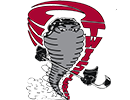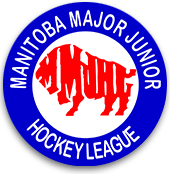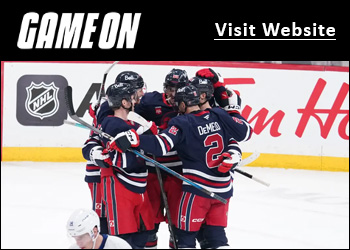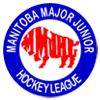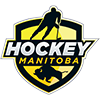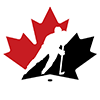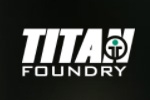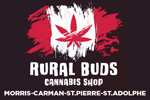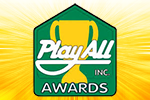MANITOBA MAJOR JUNIOR HOCKEY LEAGUE
THE EARLY YEARS
By Jack McKenzie
Founding President
LEAGUE FORMATION
It was the spring of 1970, long before the advent of Double “A” and Triple “A” hockey. All minor hockey in Winnipeg was operated out of community centers. I was involved in the operation of the hockey program at the River Heights Community Center. We had just completed another successful hockey season and had a large number of talented hockey players at the Juvenile level who had nowhere to go in the fall. Their only option at that time was to go into the Junior “A” program.
The Greater Winnipeg Minor Hockey Association, which controlled all minor hockey within the City of Winnipeg at that time, did not have any interest in hockey above the Juvenile level. This left just the Junior “A” program as the only option if a graduate from the Juvenile program wanted to continue in hockey.
The City of Winnipeg was divided into four zones, in so far as Junior Hockey was concerned. Namely a team from St. Boniface in the east, the West Kildonan North Stars in the north, the St. James Canadians in the west, and the Winnipeg Monarchs in the south. If a boy wanted to play Junior Hockey in Winnipeg at that time, they had to play for one of these four teams, or he did not play at all.
The Junior Teams operating in Winnipeg had an arrangement with the Manitoba Amateur Hockey Association and the Greater Winnipeg Minor Hockey Association that allowed them to “protect” up to nineteen players in their zone of the City of Winnipeg. Such players were boys they had identified (scouted) as players they would like to have on their teams – ie – future prospects – and/or players that they could draw on to fill in for players on their rosters who were injured or otherwise unable to play.
The problem with this “List” was that the players who found their names on such lists had no say as to whether or not they wanted to be so named. If, for example, a player living in south Winnipeg found themselves named on the list of the Winnipeg Monarchs, and they moved to – let's say, Dauphin, Manitoba and wanted to play for the Dauphin Junior “A” Hockey Team, they had to get a release from the Winnipeg Monarchs before they could play for the Dauphin team.
About ten years earlier, a group of individuals in Winnipeg attempted to organize a Junior “B” league. Unfortunately, their efforts ended after about two years of operation.
MAHA APPROACHED
With the idea of Junior “B” Hockey in the back of my mind, I paid a visit to the office of the Manitoba Amateur Hockey Association, then located on the mezzanine floor of the old Winnipeg Arena. The office was run by their then Executive Director, a chap by the name of George Allard. We had a nice visit in which I asked him what might be involved in establishing Junior “B” Hockey within the City of Winnipeg.
George advised that if a group of individuals representing potential Junior “B” teams came forwarded, that the MAHA would be happy to work with them.
With this in mind – the formation of a Junior “B” League - I then sent out a letter to a number of groups in and around Winnipeg – primarily groups that I was able to identify who were involved with Juvenile Hockey Teams and had access to one of the few local arenas - inviting them to a meeting to discuss the possible formation of a Junior “B” hockey league. The idea was that such a league would start operation in the fall of 1970.
The meeting was held in the auditorium of the River Heights Community Centre. That was mid-April of 1970 and representatives from approximately six areas in and around Winnipeg, attended. In spite of the fact that I was directly involved with one of the groups looking to form a new Junior “B” team – The River Heights Cardinals – the representatives of the other teams asked me to act as league president. The formal name of the Manitoba Junior “B” Hockey League, was adopted.
The next step was formally approaching the Manitoba Amateur Hockey Association.
A meeting was arranged in the MAHA's office one evening in the early summer of 1970, which was attended by not only representatives of our group, and MAHA Directors, but also representatives of each of the four Winnipeg based teams that made up the Manitoba Junior Hockey League.
George Allard acted as the unofficial chairman of the meeting and advised those present that he had received a request from our group to form a Junior “B” hockey league in and around the City of Winnipeg, with the expectation that we start to play in the fall of 1970. He then went on to say that the MAHA just happened to have received an application from each of the four Junior “A” Hockey Teams that made up the MJHL, for Junior “B” Teams to play in the City of Winnipeg this fall and seeing as how their applications happened to predate ours, that we would have to work out some form of a working agreement with the MJHL if we wanted to proceed.
That led to a discussion on what they – the MJHL – saw in such an agreement. They saw our teams operating as “Farm Teams” to their Junior “A” Teams with their being able to draw on our players as they saw fit. In other words, if they needed a player to fill in for one of their regular players for a specific game, that they would be able to do so.
We explained that we would be happy to work with them, but that there was no way we were going to force a player to go and play for them unless the player actually wanted to.
We went on to explain that our league was founded on the understanding that none of our teams would stand in the way of any boy who wanted to play hockey for another team – ie – wanted to play for one of the teams in the Manitoba Junior Hockey League or the Western Canadian Junior Hockey league. If we were to make some type of a working agreement with the MJHL, we expected that they would agree to a similar deal – that they would not stand in the way of any boy who wanted to play or one of the teams in our league.
The meeting concluded without anything having been agreed upon. The two groups understood the other's position and the idea was to discuss things over amongst themselves with the hope of a subsequent meeting to see if an agreement could be reached that was satisfactory to all parties.
MJHL MEETINGS
The next contact between our group and the MJHL was in the form of a phone call I received from the owner of the Winnipeg Monarchs, a chap by the name of Bob Westmacott. Bob invited me to have lunch with him to discuss our proposal.
We met for lunch at the Charterhouse Motor Hotel in downtown Winnipeg.
During our lunch, I explained to Bob our desire to work with them but in no way would we agree to anything that required our providing players to their teams without the individual player's agreement, or would restrict a player from playing in our league if the boy so desired. He would not have to get a release beforehand.
Bob then noted that we had three groups in the same area of Winnipeg from which he drew his Winnipeg Monarch players, namely the Ft Garry Blues, The River Heights Cardinals, and the Charleswood Hawks. He questioned where we thought we were going to find enough players to fill the rosters of three Junior teams when he had trouble finding enough players to attend his training camp each year, to staff a single team.
He was surprised at the comment I made that most, if not all of our teams were charging our players a registration fee in order to play, in order to help cover operating costs.
Our lunch concluded without anything being resolved.
FRANK McKINNON
The next step was a request for us to attend a meeting of the MAHA, to be chaired by their then President, Frank McKinnon, in their Winnipeg Arena office.
Our group (The River Heights Cardinals, The Charleswood Hawks, The Ft Garry Blues, and a team from Stonewall) met following receipt of the invitation and reviewed our position. All agreed that we were not interested in becoming development teams to the Winnipeg Junior “A” teams and that, while we would like to operate with the blessing of the MAHA, that we were going to operate starting in the fall, with or without their permission. As such, I was instructed to attend the meeting as a single voice on behalf of the four groups.
The meeting was held in August in the MAHA's office in the old Winnipeg Arena. In addition to some MAHA Directors, representatives of the four Winnipeg Junior “A” teams attended. They were surprised that our group did not attend with representatives of each proposed team.
The meeting reviewed the position of our group and the fact that we were unable to reach an agreement with the Junior “A” teams. I explained that our position had not changed since my meeting with Bob Wesmacott of the MMJHL Winnipeg Monarchs, earlier in the month.
At this point in the meeting, one of the representatives of the Junior “A” teams in attendance, made the remark “Bob, you never told us you had met with them”.
I told the MAHA representatives that we were not interested in interprovincial play-offs as our plans were to have our playoffs concluded so that the majority of our players, who attended university, could concentrate on their spring exams without having to concern themselves with hockey playoffs at the same time.
George Allard then commented that he expected we would not operate without the blessing of the MAHA to which I replied that our four teams had ordered their equipment and uniforms, made arrangements for ice time in four arenas, and would be proceeding to start to play that fall, with or without the MAHA's approval.
At that point, it appeared there was nothing to be gained by continuing discussion, and the meeting concluded.
As the meeting was breaking up, Frank McKinnon took me aside and asked that we hold off proceeding for a couple of weeks, to give him the opportunity to see if he could work something out to fit our position. I agreed and promised to keep in touch.
Not having heard anything from Frank, during the last week of August, I picked up the phone and called him at his high school office in Carman, Manitoba (he was the Principal). Our conversation was short as Frank advised that he had been unable to do anything with the MJHL representatives that would allow us to reach an agreement.
I thanked him for his efforts.
He wished me the best and we concluded our discussion.
St. JAMES SURFACES
About this time we learned of another group that had heard of our plans, namely a group from St. James led by Bob Stewart. They were invited to join with us, however, they advised that they had received pressure from the MAHA to stay away from our group as the MAHA had made arrangements for additional Junior “B” teams and would be operating a league for them to play in, starting in the fall.
This left our Junior “B” group with four teams, so we drew up a schedule and commenced play late that fall.
MAJOR JUNIOR IDEA
As we had not been able to make an agreement that saw us fall under the CAHA, one of our team representatives brought up the idea that we explore the idea of following the rules of the then Western Canadian Major Junior Hockey League which allowed each team to carry four players, age 21.
All agreed that this was in order and the name of the league changed to the Manitoba Major Junior Hockey League.
Each team was allowed to carry any player age 21 (over age) that first year, with the understanding that in subsequent years, the four overage spots on each team would have to be filled with players who had played their previous year on a team within our league. We were not going to become a place for boys to play an additional year of Junior Hockey who had not played the previous year in our league.
INAUGURAL SCHEDULE
Our league had been playing but a week when I received a call from Bob Stewart of the St James group, whom I knew from previous minor hockey organizations – he was involved with the Deer Lodge Community Centre. Bob advised that their group, along with a group from Portage La Prairie led by Maurice Blanchard, had been sold a bag of goods by the MAHA and that the promised Junior “B” league did not exist. They had no one to play against, other than each other.
He asked if there was any way that we could work something out with them that would allow them to become part of our league.
Following a quick meeting of the existing four teams that made up our league, the schedule was revised to accommodate the addition of Portage and St. James.
ICE PROBLEMS
We had a league with six teams, but just five arenas.
Charleswood had a team but the new Eric Coy Arena was behind schedule and not scheduled to open in time for the start of our first season.
What to do?
Their arena was expected to open around the first of the new year, so one option was to schedule all of Charleswood's games as away games, for the first part of the season.
Not satisfactory but that was a possible solution to the problem.
Then I realized that the River Heights Arena was not used on Saturday evenings so arrangements were made for Charleswood to rent that arena on Saturday evenings until their new facility was completed. We had two teams playing out of the same arena, and while not ideal, worked out well.
LAST MINUTE DETAILS
With a league established, there were a number of behind the scene items to be worked out. We met as a league and decided seeing as we were not under the control of the CAHA/MAHA, we did not have to follow all of their rules in so far as play was concerned. Following discussion, it was agreed that we would adopt having a defensive player having to actually skate down and touch the puck, on an icing call – not just have the puck cross the red goal line as was the practice in most amateur hockey.
This rule change took a little getting used to by the referees, however worked out well and was enthusiastically endorsed by the players.
REFEREES
The next item of business was finding someone who had contact with qualified referees and would undertake hiring and scheduling them for our games.
We had elected to go with a two-man system, in order to keep costs down.
The name of Bob Foulds was suggested. Bob was a part-time referee and the owner/operator of a small bicycle and sporting goods store on Corydon Avenue – Corydon Cycle. During the winter season, Bob operated a skate sharpening business out of the back of his shop and gained the reputation as one of the best places in Winnipeg to get your skates sharpened.
As such, many of the officials took their skates to Bob to be sharpened, hence he was in regular contact with them.
Bob agreed to become our Referee-in-chief and did an excellent job. In addition to officiating himself, some of the names of individuals who worked for our league in the first year or two include Billy Clements, Len Cowie, Earl Ormshaw, and Gord Kurger, to name a few.
We had the suggestion of a problem, that first year, where some of the referees reported that there was an indication from one of the chief referees of another league, that if they worked games in our league, that they would be prohibited from doing so in MAHA sanctioned leagues.
Nothing came of it, however in an effort to assure our referees that we would stand behind them should any disputes arise from on-ice activities, we hosted a breakfast just for our referees, one Sunday morning at a local motor hotel. It was well received and helped to solidify our relationship with a good crop of senior referees.
None of the other leagues had ever bothered to sit down with their on-ice officials, hence our gesture was well received.
PIONEER DIRECTORS
I would be remiss at this point if I did not acknowledge a small group of individuals who worked with me, behind the scenes, in getting the league off the ground.
Bob Fitzpatrick was the behind the scenes steadying voice of not only the Ft. Garry team, but he also contributed greatly to league matters, particularly during our early dealings with the MAHA. Don Johnson was the on-ice team manager for Ft. Garry, and Chip Adams the Blue's coach for the first year or two.
Ed Rutherford was not only the general manager of the Charleswood team but also the individual who put up the funds to get the team off the ground. He was assisted by Ron Russell, who helped in an executive capacity at the league level, something we greatly appreciated in the early days of the league.
Richard Partridge, who contributed behind the scenes, for the River Heights Cardinals and the individual who graciously gave his time – without pay - to coach the River Heights team for the first six years of its existence. Gordon Marks, also of the River Heights team, are individuals whose names come to mind.
Thanks to all of them for their contribution.
MINNEDOSA
Our league was now well underway when I received a phone call from a chap in Minnedosa, Manitoba. I suspect that he was directed to get in touch with me by Gerry Brisson who, at that time was involved with the Brandon Wheat Kings. Gerry had some players that he assigned to the Minnedosa group and, I further suspect, in return, picked up some of their operating costs.
The chap, whose name I have long forgotten, asked if they could meet with us and discuss the possibility of our league teams playing some exhibition games in their town against their Junior “B” team. He explained that they had a Junior “B” team that they entered in provincial playoffs each spring, but had no one to play against. He further explained that in past years they played some exhibition games against local area intermediate hockey teams, but that did not give them the competition they felt they needed in preparation for the spring MAHA Junior “B” Playdowns.
Arrangements were made to hold a face to face meeting in Portage La Prairie a few days later.
I, along with representatives from the Charleswood and Ft Garry teams, drove to Portage and met with the delegation from Minnedosa. At the meeting they explained that they hoped we might consider sending out teams to their town, on a rotating basis, over the winter, effectively giving them 12 home games.
We explained that we were not really interested in exhibition games, as our experience showed teams did not take them seriously and they were often, more trouble than they were worth.
The idea of making the proposed games count in our league's standings, in so far as our six league teams were all concerned, was suggested and in the end, agreed upon.
A deal was concluded that would see us send each of our teams, twice over the winter – on Fridays so they had Friday nite home games in their town. Each game would be counted in our league's standings.
Part of the negotiations saw them provide, and pay for, MAHA certified Junior Hockey level referees, for said games. As we did not want our teams traveling by car to and from such games, they agreed to pick up the cost of a charter bus from Winnipeg, for each game. As an added touch, much appreciated by each team, was there providing a take out chicken dinner for each of our team's players to eat on the bus ride home.
It should be noted that we were able to secure a discounted price for the charter bus trips by having the league negotiate for all the trips with a single bus line.
Southern Bus Lines of St. Vital was our carrier which worked out exceptionally well – even if the age of their bus was such that it would have matched the bus used in the movie “Slap Shot”!
Although this arrangement worked out just fine from our point of view, the cost to the Minnedosa team proved too much to see them continue past that initial season.
One note of interest here has to do with the results of the games. Most of our teams won the games in Minnedosa, so as the end of the season approached, one of our Winnipeg based teams, making their second trip of the season to Minnedosa, and having beaten the Minnedosa team during their first meeting, allowed a group of their fans and girlfriends to accompany them on the charter bus. Apparently, they partied on the way to the game and did not take the game seriously. The result was a victory by Minnedosa. The loss of the two points in league standings cost them a position in the league standings come playoff time.
AFFILIATE PLAYER PROBLEMS
As we were now an “Independent” league, with our players not signed to CAHA registration cards (we had our own), we ran into some situations with a couple of our rural teams that had a working arrangement of some sort with the Junior “A” team in their area (Portage in year one and Selkirk in year two or three). Each team carried a few players that their Junior “A” team hand an interest in, but could not use unless they were on a CAHA card. The rural Junior “A” teams were not allowed to carry a 19 player “Affiliated” list as were the Winnipeg based teams.
So, to accommodate our rural partners, we allowed such teams to sign their players to Junior “B” CAHA cards if needed. Such players were restricted to playing a maximum of three games with a Junior “A” team, as long as the team in our league was still engaged in league or playoff competition.
In keeping with the idea that boys should have the option as to whether or not they wanted to be affiliated with any particular team, we created what we called “Affiliated Player” cards. Each team was given 19 such cards, the idea being that they could ask up to 19 minor league players – ie – Midget and Juvenile level players – to sign on as an “Affiliated Player” with one of our teams. That allowed the player to play up to three games with our Major Junior Team, as long as their primary team was still in league or playoff competition. Following the conclusion of that player's minor league team, they could be used by the Major Junior team without regard to the three-game limitation.
The boys had to confirm that they were agreeable to such an arrangement by signing the card. The Major Junior team could not simply put their name on a list!
EXPANSION
As the league progressed, It expanded and contracted. The Stonewall team ceased operation after two years because of a lack of volunteers to run their organization, however, they were replaced by teams from Selkirk, Transcona, St. Boniface, St. Vital, as well as teams from both East and West Kildonan.
Individuals or groups approached us from as far away as Kenora and Thompson, Manitoba, however, all were rejected due to costs and/or travel distance.
Remember, our league was formed with the idea of providing a place for boys to play Junior Hockey and still be able to attend school or university. This eliminated the idea of a league that involved regular long-distance travel.
We did make an arrangement with a group from Kenora, Ontario. They had two high schools in that town at that time, which combined to form a single team for provincial playoffs. They, because of their location on the western edge of Ontario, had little or no competition. We agreed to send some of our teams to Kenora to play exhibition games against a combined local – primarily high school hockey players - team.
ALL STAR GAME
The idea of not only selecting an all-star team from our league but also staging an All-Star Game was discussed at a league board meeting.
Following discussion and further research on the idea, Terry Hind, who had become involved at the executive level with the Charleswood Team, volunteered to organize such a game. The team was selected by the league's coaches, with their not being able to vote for any player on their own team. The game was a success and led to a similar venture the following year.
In an effort to help the local group promote the idea of Junior Hockey in Kenora, we agreed to have our All Star Team play a game against the local combined Kenora High School hockey team. The game worked out well but the idea of a Junior team in Kenora just could not get off the ground.
The game in Kenora was the first and only time I can recall one of our games being carried live, play by play, over a local radio station.
In a subsequent year, we provided similar competition on an exhibition game basis, to a group representing a high school hockey team in Steinbach, Manitoba who were trying to “get in shape” for spring high school hockey playoffs.
TRIPLE “A” HOCKEY
Remember, when the league was formed, there was no double “A” or triple “A” minor hockey, in Winnipeg, as we know it today. There had been attempts to form such leagues but they had been resisted by the GWMHA. An “independent” group established a couple of what they called “AAA” Teams around Winnipeg, nothing like the “AA” and “AAA” levels we know today.
That having been said, our teams were constantly approached by players, or parents of players, age 17 and under. Most such players were above average for their age and might have fit in our league.
Remember, during the first year of operation, our league had three full-time players, age 15 (Brian Engblom with Ft. Garry; Don Houston with River Heights and Ray Russell with Charleswood). Hence our league had no restriction as to how old a player had to be to participate on a team.
It was starting to become a problem when Nick Hill came up with the solution.
He would operate a team in our league made up of players age 17 and under. He would draw players from all of the areas (ZONES) represented by our teams.
The name of his team was the “Kern Hill Nationals”.
The idea was, and it worked to perfection, that if one of our teams was approached by a player/parent of a boy age 17 or under, who thought they were good enough to play in our league, they would be directed to Nick's team and if they could make it, they could play in the league.
Once such players attained the age of 18, they became eligible for the team in our league in the area they resided.
Was it a success?
You bet it was – and, boy, could they skate! Their lack of size was made up for by their speed.
They made the playoffs their first year in existence. The need for such a team has been eliminated in recent years thru the advent of triple “A” hockey at the Midget Level.
PUBLICITY
Publicity – something we sought from year one – but had a hard time achieving.
Yes, we held a number of Press Conferences where we tried to wine and dine the local sports reporters in the hope that we could influence them into giving us more print and vocal coverage. We were nominally successful, and while we continued with our efforts, could not overcome the coverage awarded to the MJHL.
The topic was discussed at many board meetings. The idea of paying a reporter in return for additional coverage quickly rejected.
Then, someone at one of our meetings suggested we consider hiring one of the reporters as our league statistician. This was done and we hired the nite sports editor – Fred Collins - of the then, Winnipeg Tribune Newspaper, as our league statistician.
The concept worked exceptionally well. We had up to date statistics of our games and players, with daily coverage of up-coming and completed games – complete with pictures.
Each home team was responsible for delivering a copy of the game sheet to the Winnipeg Tribune's sports department each evening following a game, and Fred took it from there.
With the drinking age in Manitoba being lowered to 18, local breweries started to pay more attention to our league with Labatt's leading the way. They provided each team with what amounted to financial aid – if not exactly in the form of cash.
We used their Blue Room, from time to time, for meetings and press conferences.
At one such Pres Conference in Labatt's facility on Notre Dame Avenue in Winnipeg – their “Blue Room” - we invited some of the Labatt's staff to attend. They had no idea what to expect.
Our purpose was to say “Thank You” to Labatt's for all the support they had given us over the years, in the form of a plaque formally acknowledging their support.
They were most appreciative of our gesture, noting that in the past all they ever received from sports teams were requests for something. This was the first time any group had reversed the equation by giving something to them.
Our plaque hung in their Blue Room for many years.
GOVERNMENT
Then one day I received a call from a chap with the Workman's Compensation Board. He was evidentially familiar with how hockey worked and the completion of game sheets for each game. His question was, where the league's copy of the sheets ended up.
It turned out that he had been reading the sports section of the Tribune and came across a report on one of our games. What caught his eye was the fact that one of the players on one of the teams had received a penalty, thus was mentioned in the report.
Further discussion with the individual revealed that the player in question was an individual that he had been dealing with over a Workman's Compensation Claim. The individual was collecting benefits due to a claimed back injury at work but yet was able to participate in one of our league games.
I directed him to Fred Collins for a copy of the game sheet and never did hear what came of the matter.
While on the subject of a government inquiry into our records, another day, one summer, I received a call from Revenue Canada asking where our game sheets went following games.
I explained the delivery to our league statistician and that I did not know what happened to them once the required information had been extracted.
It appears the individual was searching for records not only from our league but other leagues as well. He was looking for the names of the referees who worked the games, apparently trying to compile a list of games each officiated at over a season, to see if they had reported the same as income on their tax returns.
I noted to the individual that if they continued with this type of investigation and forced the referees to pay tax on the money they earned for working hockey games, that they would simply force the referees to demand increased fees to cover the cost of the tax they had to pay – thus increasing the cost of amateur hockey to the players and volunteers who ran the teams.
I did speak to Fred Collins about the matter and learned that the records were destroyed following his extraction of the necessary statistical information.
I did hear that the Revenue Canada chap made the same approach to other leagues, however nothing much ever came of the matter.
One final note here. As the referees quickly learned of the government's investigation into the matter, a number of them adopting the practice of signing the game sheets with another individual's name – just in case!
MAHA PERSISTS
From time to time, over the first few years of operation, representatives of the MAHA would approach us asking what might be done to get us to join the MAHA/CAHA. As we had four “overage” players on each of our teams and did not fit in their definition of Junior Hockey, they suggested we might want to consider entry at the Intermediate level. Intermediate level hockey had no restriction as to the minimum or maximum age of a player on such teams, so, effectively we could have fit under that category.
This was something we had no interest in and was quickly rejected.
Another avenue that was discussed was our joining as affiliated teams rather than full members. Again the idea did not move forward.
I do recall one meeting, probably in 1975, in which Ed Rutherford, Nick Hill, and I had a luncheon meeting with George Allard together with some other representatives (Directors) of the MAHA. The meeting was held at the old Carlton Club on Main Street. Some discussions had taken place leaning towards our joining the MAHA in some form, and this meeting was to try and see if there was a way we could work around the remaining obstacles.
The meeting was promising, with George Allard addressing our concern that players might be restricted from playing on one of our teams because they had signed with some other MAHA/CAHA team or was on some other team's “protected” list. He stated that should a situation arise where a boy might want to play for a team in our league, who was registered or otherwise “protected” by another MAHA/CAHA team, that they would not stand in the way of such a move.
It appeared that progress was being made and we might, at long last, join the MAHA/CAHA.
At that point, we produced a legal agreement we had drafted, between the MAHA and the MMJHL. The agreement included a blanket release for any boy who wanted to play in our league and who, for whatever reason, found his name on another team's roster or protected list.
In addition, the agreement included a blanket release from our league for any boy who was registered with any team in our league who wanted to play for another team in another league.
I recall specifically George Allard stating that they would not sign such an agreement. That their promise to release any boy to one of our teams should be good enough.
At that point, the meeting concluded without any resolution to the “problem”.
AFFILIATE PLAYER PROBLEMS
As noted earlier, we had two rural teams – Selkirk and Portage – who had an agreement with the Junior “A” Teams in their towns, that called for them to put some, if not all, of their players on MAHA Junior “B” cards. This allowed the Junior “A” Teams to “call up” players for a maximum of three games during the season. Any more than three games meant that the player was no longer eligible for the Junior team in our league. And yes, we did try and keep track of the number of games such players played at the Junior “A level – primarily thru the records compiled by our wonderful league statistician, Fred Collins.
I recall one situation where Selkirk had a defenseman who was called up to fill in for the Selkirk Junior “A” Team. Apparently, no one thought anyone was keeping track of how many games he was playing. Fred was and informed me that the individual had played four games with the Junior “A” team.
Unfortunately, I had the unfortunate duty of informing the team that said the player was no longer eligible to play for them that season.
CANADA WINTER GAMES
There was another situation I feel worthy of note here, that arose during my six years as league President, and that had to do with the Canada Winter Games. Manitoba was required to select a Junior “B” Team as its representative at the games.
This presented a problem as there was no Junior “B” league to deal with. The requirement was for the MAHA to hold a week-long tournament in Winnipeg to select a team to represent the province. There was a need for four Winnipeg teams to compete against teams from rural areas. They manufactured Junior “B” teams from the Brandon area (Westman) and a team from Steinbach, as well as on from the northern portion of the province ???. Such teams were made up primarily of high school hockey players.
We were approached with the idea of our working out some sort of agreement with them that would see our filling the four spaces for Winnipeg.
Our initial reply was that we were not interested. The proposed selection tournament was to be a week-long event and would fall right in the middle of our schedule.
It appears that there was some sort of political pressure being applied to the MAHA as they persisted in their approach to our league.
They needed a team to represent Winnipeg North, one representing Winnipeg South, one representing Winnipeg East, and a fourth representing Winnipeg West. None of their “zones” came close to agreeing with our existing team areas.
Following much deliberation, we agreed that we would participate in their tournament with four of our teams being delegated to fill the four Winnipeg “zones”. We agreed that the four teams in the first four places in our league standings, as of a certain date, would fill the four Winnipeg spaces in their tournament. As to which team would fill what zone it would be decided by the flip of a coin.
Oh yes, we had agreed that for the purposes of the tournament, we would exclude our overage players.
Then the MAHA noted that in order to participate in the tournament, ALL PLAYERS ON ALL TEAMS would have to be signed to Junior “B” cards.
We did not have a problem with this, as long as the MAHA was prepared to accept the players on our league teams, as is.
We were told that once we had said players signed to MAHA cards, that if we wanted, we could leave the players on said cards for the balance of the year. That was to be our option.
Again, we reviewed this option at our league level. We could see no disadvantage to leaving the players on such cards. As a matter of fact, there was an advantage. If our players were on CMAHA/CAHA cards, should they ever be drafted at the NHL level, the team they played for might receive some of the draft money paid to amateur hockey, but only to CAHA registered teams.
So – we proceeded to select four teams and register their players on MAHA cards.
Being wary of our dealings with the MAHA, a photocopy of all such player cards was retained – just for future reference – before they were sent to the MAHA. They were sent in as one package with an accompanying letter advising that we wanted to leave the cards registered with the MAHA/CAHA following the tournament.
Shortly after receipt of the cards, George Allard called me saying everything was in order, with the exception of one player on the roster of the River Heights Cardinals, A boy by the name of Greg Warren. Apparently, Greg had played some games for the Winnipeg Clubs of the Western Canadian Major Junior Hockey League and was the property of that club. Without a release from that club, the MAHA would have to exclude Greg from the tournament.
Knowing the Coach and General Manager of the Winnipeg Clubs – Gerry Brisson – I met with him to see what might be done to rectify the situation.
Gerry was most anxious to help but did not want to give up his rights to Greg, in so far as the Western Canadian Major Junior Hockey League was concerned. He agreed to sign a release allowing Greg Warren to play for the River Heights Cardinals of our league only, but if Greg wanted to play for any other CAHA team, then his rights reverted to the Winnipeg Clubs.
With this release in hand, I quickly convened a meeting of the four teams selected to play in the winter games tournament and explained what had transpired.
It was the unanimous decision of the group that we would go back to George Allard and the MAHA with the release from Gerry Brisson for Greg Warren and tell him that they either accepted the four teams and their declared players – including Greg Warren – or none of our teams would participate in the tournament.
I delivered the release and message to George. Greg Warren was allowed to play and the tournament proceeded as planned.
And no, one of our teams did not win the tournament. The tournament was won by the Westman team from Brandon.
One final note on this subject and that has to do with the MAHA/CAHA player cards all our players had signed. After some time had passed and the team copy of the player cards had not been returned to the individual teams, I wrote a letter to the MAHA asking where the cards were.
The answer I received – verbally – was that George had destroyed the cards following the tournament.
EXECUTIVE SECRETARY
At the end of the fifth year of competition, I informed the Directors that the job of running the league had reached the stage where we needed to consider hiring someone, at least on a part-time basis. The idea was that this individual would act as the league's secretary, handling the record-keeping of the league's meetings, the player registration, the statistics as well as the banking.
They agreed and an individual who was familiar with our league, having been involved with the Charleswood team, Gerry Probert, was hired to fill the position.
That was a load off my back as I now had assistance in dealing with league matters, thru Gerry. He was given my collection of meeting minutes, etc., dating back to the founding of the league and our various meetings with the MAHA, several boxes of files.
FUND RAISING DINNER
It was becoming more expensive every year, to fund the operation of our teams. Some had attempted local fundraising dinners, with mixed success.
Then, at a Board Meeting in early 1974, Nick Hill proposed the idea of holding a league-wide, fundraising dinner.
All agreed.
The idea was that the profit from the dinner would be returned to the teams based upon the number of tickets each sold.
Nick explained that the dinner was to include a cash prize of $1,500 and, in an effort to attract as large a crowd as possible, would feature a keynote speaker.
That was the spring that the Philadelphia Flyers had won the Stanley Cup – the first expansion team to do so. They were coached by Fred Shero, a Winnipegger whom Nick knew from growing up in North Winnipeg.
Nick arranged for Fred to travel to Winnipeg and be our after-dinner speaker. He didn't charge us a fee, as Nick had convinced him to appear without charge – his appearance being his contribution to amateur hockey. We just picked up his travel expenses.
Nick even went so far as to put Fred up in his home, to save hotel and meal costs for the league.
Then, to complete the show, we hired sports reporter and local radio and TV commentator, Jack Wells as the evening's MC.
The dinner, which included the awarding of the various league trophies, was held in the ballroom of the Victoria Inn – the largest banquet facility then available in the city.
The place was packed and in spite of the fact that we awarded the large cash prize and provided free drinks throughout the entire evening, we were able to return $37.50 per ticket sold, to the various league teams.
With the success of the first year's event, the fundraising dinner was continued thru year two, again with Jack Wells as the MC, and this time with Phil Esposito as the speaker. The event was as successful as year one.
SIX YEARS LATER
After six years as league President, it was time for a change.
I had enjoyed the position, in spite of all the ups and downs involved.
The league was firmly established and had a hard-working board of directors to carry on.
So, in June of 1976, I stepped down as President.
Ed Rutherford of Charleswood replaced me, someone who had been involved from the start, who knew most of the details and battles we had fought and was in a fine position to take over.
Looking back as I compile this history of “The Early Years” I am happy to see that after fifty years it continues to offer a place for boys to play Junior Hockey. The players still manage to fit in full-time studies towards higher education and play hockey at the same time. Someone must be doing something right.
 League Menu |
|---|
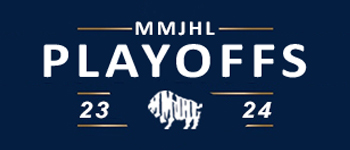
|
|---|
| SERIES A | ||
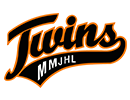 |
Ft.Garry/Ft.Rouge Twins 1 | |
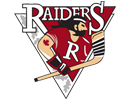 |
Raiders Jr. Hockey Club 8 | |
| SERIES B | ||
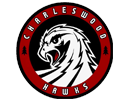 |
Charleswood Hawks 2 | |
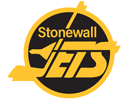 |
Stonewall Jets 7 | |
| SERIES C | ||
 |
Transcona Railer Express 3 | |
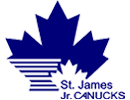 |
St. James Jr. Canucks 6 | |
| SERIES D | ||
 |
St. Boniface Riels 4 | |
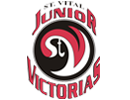 |
St. Vital Jr. Victorias 5 | |

Leading Scorers
Playoffs 2024-2025
|
|---|
| player | gp | g | a | pts | |
|---|---|---|---|---|---|
 |
Burzynski, Nathan | 7 | 8 | 8 | 16 |
 |
Van Den Bussche, Nolan | 10 | 5 | 10 | 15 |
 |
Sellen, Trey | 10 | 5 | 9 | 14 |
 |
Halamandaris, Carter | 8 | 7 | 6 | 13 |
 |
Davis, Connor | 8 | 5 | 8 | 13 |
 |
Davis, Cole | 8 | 6 | 5 | 11 |
 |
Gorchynski, Dean | 8 | 3 | 8 | 11 |
 |
Hueging, Ryland | 8 | 3 | 6 | 9 |
 |
VanDeynze, Alex | 8 | 3 | 6 | 9 |
 |
Bruchanski, Kaden | 10 | 2 | 7 | 9 |

Leading Goaltenders
Playoffs 2024-2025
|
|---|
| Minimum 120 Minutes Played | ||||
| goaltender | mp | gaa | sv% | |
|---|---|---|---|---|
 |
LaRocque, Owen | 477 | 1.63 | .941 |
 |
Delaronde, Sage * | 574 | 2.09 | .936 |
 |
Pauls, Alex | 238 | 2.27 | .904 |
 |
McLeod, Jackson | 264 | 2.50 | .917 |
 |
Gordon, Keegan | 541 | 2.55 | .929 |

